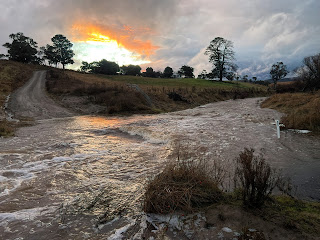Winter Solstice Musings: Still Life
Another flood has come and swept away roads and fences at my farm. I am locked away from the world once again with time to slow down and reflect.
The problem with reflection is that everywhere you look you will always find a new job or two. Rural life is only manageable when you let the rhythm of the seasons guide your steps.
Three floods (since the drought broke) carried away one of my 100 year old fences. Associated gales brought down lots of trees. Mountain folk call fallen trees "wind-gifts". Gifts or not, the fences have to be rebuilt and the trees cut off fences and removed from pasture.
Just recently I have had to cut and dress wood for stays and posts miles from any track. I was able to use fallen trees for some of the repair work. I have attended to these tasks with only shreds of recollections of how my father or his father would have done things. For here, little things matter: a stone or nail on the top of a post indicates a true boundary line.
My wire work lacks the beauty of my forebears tight wire tie-offs, but then, out here my only overseer is the wind, and she offers scant opinion on my handiwork. Don't get me wrong. I am not complaining. The White Wombat Falls are atop the gully i am working in and both Mountain Gully Falls and Mulloon Creek are within striking distance when i need to relax.
Unlike the wind, the tools show their displeasure at hard work by breaking.
Wooden handles wear out. Iron just needs oil, some sharpening and a lick of paint. I still use a lot of very old iron: hoes, picks, saws, hammers, shovels, spades and rakes. I have a sickle to cut grain and a machete to get me through thickets of bush. These days it is surprisingly difficult to find decent iron tools for love nor money.
Around Winter Solstice time, the sun pumps out no heat. Some of the First People drew the conclusion that the sun itself only emits light, and that radiant heat comes from an unseen source in the skies near the Southern Pleiades. The theory is hard to doubt at the solstice, when working in the fields becomes unattractive. This is a good time to repair broken tools. The process is simple. First, make a nice warm fire, then burn out old handles of 'broken' axes, spades and sledgehammers.
I hate to see good tools go unloved for the lack of a bit of attention. I rather think that the Roman writer Marcus Terentius Varro (116–27 BC) thought similarly. In his work "On Agriculture" (one of those useful Roman texts that survived in its entirety) he set out the number and types of tools for certain farms. He also made this important point:
"...the following rules may be laid down: nothing should be bought which can be raised on the place or made by people on the farm, in general articles which are made of withes and of wood, such as hampers, baskets, threshing-sledges, fans, and rakes; so too articles which are made of hemp, flax, rush, palm fibre, and bulrush, such as ropes, cordages, and mats."("De reliquo instrumento muto, in quo sunt corbulae, dolia, sic alia, haec praecipienda. Quae nasci in fundo ac fieri a domesticis poterunt, eorum nequid ematur, ut fere sunt quae ex viminibus et materia rustica fiunt, ut corbes, fiscinae, tribula, valli, rastelli; sic quae fiunt de cannabi, lino, iunco, palma, scirpo, ut funes, restes, tegetes. De Re Rustica, Loeb, pp238-9)"
I follow Varro's rules strictly. They bear more than a modicum of common sense.
Having burnt the old wooden handles out, i use wood cut on the farm to restore the tools to working order.
Still Life: Rejuvenating iron tools
A well balanced tool, with a handle with the right amount of spring, can do a ton of work. A poorly balanced tool can kill you. A tool without spring can split or jar.
I prefer wood cut from Black Sallee Gums (E. stellutata). I cut and cure the wood to give a range of different handles according to the type of tool. This wood has a fair amount of moisture in the wood, even when cured, and remain soft to the touch and shock absorbent.
It is amazing how fast you can shape a handle with a sharp tomahawk (to remove anything that could hurt during use. Tis never as pretty as shop bought fancy gear, but it works. I have not had much luck with shop bought ones: they can be light and beautifully turned, but they are very expensive and (furnace cured to remove any hint of moisture) break far too fast. Tools need a handle with the right type of spring and a slightly different understanding that a consumer based economy cannot provide.








Comments